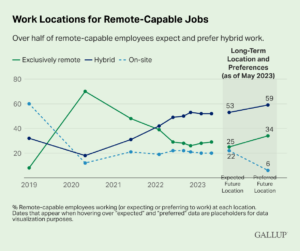Since the pandemic, many companies have adopted hybrid marketing teams, blending remote and on-site work in response to changing employee preferences.
According to a Gallup survey, over half of remote-capable employees now expect and prefer these hybrid work arrangements. This widespread preference means we need new ways to keep everyone connected, engaged, and always getting better at what they do.

This article provides practical tips to help businesses boost their hybrid teams’ skills, focusing on clear communication, continuous learning, and collaboration.
1. Establish Clear Communication Channels
Effective communication is the foundation of a successful hybrid team, where members might be spread across different locations. Establishing channels that everyone can access and use easily keeps the team cohesive and well-connected.
For entrepreneurs, adept team management helps align both remote and on-site team members with the company’s goals, fostering a work environment that promotes efficiency.
Here are some key practices to consider:
- Unified Communication Platforms: Choose platforms that combine video calls, messaging, and file sharing into one accessible hub. This approach helps all team members stay on the same page, regardless of their location. Having a unified platform can help teams streamline their communication, reducing the need to switch between multiple tools.
- Regular Check-ins: Set a routine for daily or weekly meetings. These don’t have to be long — a quick 15-minute video call each morning can suffice for team members to share updates and flag any issues they’re facing. Regular check-ins help maintain a sense of connection and accountability among team members.
- Clear Documentation: Keep all team members updated with real-time access to documents. Allowing everyone to see updates as they happen helps in managing tasks more effectively and maintains transparency within the team. Clear documentation practices include organizing files in a logical structure, using consistent naming conventions, and keeping records of changes and decisions.
- Feedback Channels: Create specific channels for feedback, whether through an end-of-week email prompt or a dedicated space in team meetings for suggestions. This opens the floor for team members to express thoughts and contribute improvements actively.
2. Build a Culture of Collaboration

Building a culture of collaboration in a hybrid team involves creating an environment where remote and on-site team members feel equally involved and valued.
This can be achieved through strategies that promote interaction and teamwork, regardless of physical location.
Here are some strategies and examples that would help:
Virtual Team-Building Activities
For hybrid marketing teams, consider organizing regular virtual events that engage team members in both fun and professional development. Host interactive workshops where team members can collaborate on crafting marketing strategies or brainstorming sessions for upcoming campaigns.
Additionally, you could arrange virtual coffee breaks or lunch meetings where team discussions are more about sharing personal and professional experiences, and improving team rapport. These fun activities can break the ice and build rapport among team members who might not interact face-to-face.
Rotating Meeting Times
To accommodate different time zones and work schedules, it’s helpful to rotate meeting times. This approach helps prevent any one group of team members from consistently having to attend meetings outside their normal working hours.
For example, if your team spans from the U.S. to Australia, you might schedule a meeting at 9 AM EST one week, which is early evening in Australia, and then at 4 PM EST the next week, making it morning in Australia. This rotation allows all team members to share the convenience and inconvenience of meeting times fairly.
Joint Projects
Encourage collaboration by assigning projects that require input from both remote and in-office team members. For example, a marketing campaign might be divided with strategy development led by on-site staff and digital execution handled by remote workers.
Regular In-Person Meetups
If possible, organize quarterly or bi-annual in-person retreats where the whole team comes together for workshops, training, and social activities. This can help build stronger relationships and create a united team atmosphere.
For teams without a central office or those spread across different regions, using coworking spaces is a practical option. Use our platform, Coworker.com, to find and book coworking spaces. Simply search by city or space on our website to discover different coworking options nearby.

3. Implement Regular Training and Development
Regular training and development keep hybrid teams up-to-date and ready to tackle their tasks. Given that team members might be spread across different locations, structured training helps everyone gain the same skills and knowledge.
Effective Ways To Conduct Training
- Online Workshops and Webinars: Organize virtual sessions that can be accessed by all team members, whether they are at home or in the office. These sessions can cover everything from new marketing techniques to updates on industry standards.
- E-Learning Modules: Use online courses that team members can complete at their own pace. These modules can be tailored to specific roles within the team and include assessments to monitor progress. You can also create your own courses. To make this process easier, you can consider AI course creators like Coursebox to quickly develop custom training content.
- Peer Learning: Encourage team members to lead informal training sessions based on their areas of expertise. For instance, a team member experienced in SEO could lead a brief online session explaining the basics of SEO and sharing tips for optimizing content. This not only helps with skill sharing but also strengthens team bonds.
- Regular Updates: Provide updates on new tools and technologies that could affect your team’s work. Quick, regular briefings or emails can keep everyone informed and ready to adapt.
- Feedback on Training: After each training session, collect feedback to understand what is working and what can be improved. This feedback will help make future training more effective and relevant.
- Creating Presentations: Creating presentations helps in training, providing project updates, and sharing new ideas and strategies. Use tools like Google Slides, which allow team members to create, share, and collaboratively edit presentations. To make your presentations more appealing and professional, you can also use ready-made Google Slides templates from third-party sources.
Integrating these training methods can help hybrid teams maintain a high level of expertise and adaptability, helping them stay competitive and cohesive despite the physical distances between members.
4. Maintain Digital Security and Data Protection
In a hybrid work environment, don’t underestimate the importance of maintaining digital security and protecting data, especially as team members may connect from different, potentially less secure networks.
Key Areas of Focus
- Secure Communication Tools: Use communication platforms with end-to-end encryption, like Signal for messaging or secure video conferencing solutions, to keep sensitive information private.
- Data Encryption: Make sure all stored and transmitted data is encrypted. This security step is vital whether team members are sending emails, sharing files, or accessing databases.
- Secure Access Management: Implement multi-factor authentication (MFA) for accessing any work-related systems, adding a crucial security layer that goes beyond a simple password. For example, when logging into your company’s email system, you might enter your password and then receive a code on your phone that you need to enter as a second step. This extra layer of security makes it much harder for unauthorized users to gain access, even if they have your password.
- Regular Security Training: Hold training sessions to educate team members about security threats and safe practices, such as recognizing phishing attempts and creating secure passwords. For instance, you can use password management tools to help in choosing a strong password for your accounts, supporting robust security practices while working remotely.
- Policies for Data Handling and Personal Device Use: Set firm policies on managing sensitive data and using personal devices for work tasks. Tailor these guidelines to accommodate different systems. For example, if you use a Mac, you are recommended to employ specific software routines to clean up junk files, optimize system performance, and scan for security threats (for more information, see here).
5. Use Technology To Improve Productivity

In hybrid teams, using the right technological tools is crucial for improving productivity. These tools help in managing projects, analyzing data, and maintaining customer relationships, which are all integral to a successful marketing team.
Overview of Key Technological Tools
- Project Management Software: Tools like Asana, Trello, and Monday.com help teams track the progress of projects, assign tasks, and meet deadlines. They maintain alignment across team members, whether they’re working remotely or in the office.
- Data Analysis Tools: Software like Google Analytics, Tableau, or Power BI is vital for marketers to analyze trends, measure campaign success, and make data-driven decisions. These tools offer valuable insights that can prompt strategy adjustments in real-time.
- Customer Relationship Management (CRM) Systems: CRMs like Salesforce or HubSpot streamline interactions with customers and centralize all customer information, simplifying the management of leads, enhancing customer service, and boosting sales efficiency.
- Shared Online Workspaces: Tools like Microsoft Teams or Google Workspace allow team members to collaborate on documents and projects in real-time. A team could use Google Docs within Google Workspace to co-edit a marketing proposal simultaneously, allowing everyone to see changes, add comments, and discuss adjustments via a built-in chat feature. Microsoft Teams also facilitates file sharing, video meetings, and task management in one integrated space.
- Communication Tools: Platforms such as Slack enhance day-to-day communication, offering channels for different topics, private messaging, and integration with numerous productivity tools to keep conversations flowing and information readily accessible.
- Automation Tools: Automate routine tasks to save time and minimize errors. Tools like Zapier or IFTTT connect different apps and automate workflows such as social media updates, data entries, and more.
- Document Management Systems: Tools like Google Drive or SharePoint help team members access the latest versions of documents and resources, which is critical in a hybrid environment where document control and accessibility can be challenging.
In addition to these tools, incorporating AI-driven technologies can further transform productivity. AI tools can automate complex data analysis, predict market trends, and personalize customer interactions, thereby elevating the capabilities of the marketing team.
Looking Ahead
While this article has outlined several key strategies for improving the skills of hybrid marketing teams, it is equally important to stay abreast of the latest developments in hybrid work dynamics.
The preference for hybrid models shows no signs of waning, and the future workplace will likely continue to evolve in this direction.
Keeping informed about new tools and trends helps your team adapt and stay responsive to the evolving workplace landscape.









